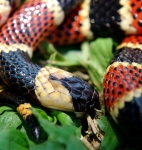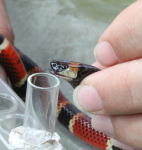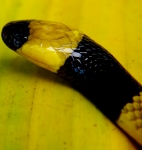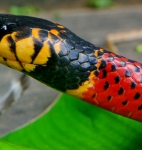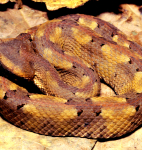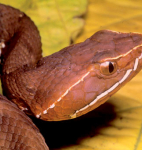Venomous snakes in Costa Rica
Part of the important research work at the Clodomiro Picado Institute consists of the identification of the species of venomous snakes found in the country. Its purpose is to know the characteristics and composition of their venom, which will help develop antiophidic or antivenom serums to treat the effects of snakebites.
Reptiles are a very diverse group; in Costa Rica snakes represent about two thirds of this group. Eleven families of snakes have been identified, among which only two are considered “possibly lethal” to humans. Thus, from 140 species found in Costa Rica, only 23 species are considered venomous.
These species of venomous snakes are divided in two large families: Elapidae and Viperidae. The Elapidae family includes a species of sea snake, Hydrophis platurus, and five species of venomous coral snakes of the Micrurus sp. genus. While in the Viperidae family, 23 species in 8 genera are identified (Agkistrodon, Atropoides, Bothriechis, Bothrops, Cerrophidion, Crotalus, Lachesis, Porthidium). Some of the main differences of these venomous snakes are the presence of a loreal pit (special structures capable of perceiving heat) in montane pitvipers (Viperidae), their particular “triangle” shaped head and the rough appearance of their scales.
Venomous coral snakes (Elapidae) have a red - yellow (white) - black - yellow (white) color pattern on their whole body, their colors are bright, and they are relatively small and thin.
The use of the R.A.N.A acronym to distinguish among Coral snakes:
We have seen a series of social network comments regarding the suitability of the use R.A.N.A as acronym to identify venomous snakes of the genus Micrurus, the Coral snakes, in Costa Rica. The idea behind these initials is to form a well-known word with the initials describing the order and color of the rings of several monadal Coral snake’s species (those with just one black ring between the red rings), distributed mainly in North and Central America. This order follows: Rojo (Red) – Amarillo (Yellow) – Negro (Black) – Amarillo (Yellow), forming the above-mentioned acronym. Similar to this, in Costa Rica it has been alluded to the image of two know soccer team flags in order to distinguish among venomous Coral snakes and false coral snakes: “the Heredianas are venomous and the Liguistas are the harmless”.
In both cases we are dealing with mnemotechnic techniques, meaning, a mental association which purpose is to remember information that tends to be forgotten but that could be valuable in the day-a-day activities. These tools allow to memorize in a simpler way an algorithm whose purpose is to distinguish between the venomous snakes of the Elapidae family and the harmless snakes that do not belong to this family. This tool allows to, efficiently, determine among common species in both groups. For instance, the more abundant Coral snakes in our country are Micrurus alleni, M., nigrocinctus and M. mosquitensis, that can be separated from the most common false coral snakes (Ninia maculata, Geophis brachycephalus, Erythrolamprus bizona, Lampropeltis spp., Pliocercus euryzonus, Oxyrhopus petolarius), using theses mnemotechnics.
It is important to clarify that the use of mnemotechnic rules as pedagogic strategies help to memorize concepts more easily, although in an artificial manner. However, none of the mnemotechnics are infallible, nor pretending to be in the knowledge-acquiring process. The information processing, selecting, and relating transcendental concepts and linked them to available information to create new mental schemes that end-up in knowledge, requires a lot more time, effort, and willingness on the target public. Therefore, complementary techniques are used as aids in educative processes.
The particular case of the acronym R.A.N.A, neither the Clodomiro Picado Institute, nor other parties that have promote its use on informative material about snakes, have claimed that it is an infallible strategy for the identification and recognition for venomous Coral snakes. There are numerous false coral snake species (species that mimic the venomous Coral snakes by having ring with similar colors), which follow the R.A.N.A pattern. Among the more conspicuous in our country, we found Scaphiodontophis annulatus and Rhinobothryum bovalii, both species are rare and associated to forest environments. Moreover, several Coral snake species of the genus Micrurus simply do not follow this color pattern: for instance, those snakes that form the triade clade (three black rings between the red rings, mainly distributed in South America), or the ones that are bicolored (such as our many-banded coral snakes, Micrurus multifasciatus and M. mipartitus). It is not true that the pale ring is always yellow in color, occurring in the populations of M. alleni and M. nigrocinctus with yellow-pale, white, and white-bone shade rings. Thus, as mentioned before, the acronym R.A.N.A does not pretend to be applied globally to distinguish Coral snakes of medical importance from those that are not.
Nonetheless, supporting the use of this mnemotechnic, R.A.N.A it is an approximation that allow the non-specialized public to distinguish between the most common venomous Coral snakes in the country, and those species considered mimics. Furthermore, the acronym invites to take a better look at the snake found. Trying to distinguish between venomous Coral snakes and non-venomous snakes, although for a few moments, the animal becomes a reflexional object; contributing with its protection if the animal is recognized as harmless.
Devalue the use of mnemotechnic tools because they do not represent, in an exact way, the dimensions of a concept, brings no favor to the environmental education, deleting the virtues that simplification and linking ideas have in the knowledge-forming process. The use of R.A.N.A should not be interpreted as a strategy to hide information nor to promote inaccurate information. The simplification used when this acronym is employed has been part of a pedagogic strategy which has become effective, at least in a great portion of the national population. Its detractors must recognize that the use of this acronym in snake informative materials, has the advantage to serve as a null model on which provide further information to a public, luckily, it is becoming more interested on the topic.
Furthermore, their venoms have different effects: coral snakes cause envenomings with neurotoxic effects, while montane pitvipers cause mainly myotoxic envenoming (affects the muscle), and hemotoxic (causes hemorrhage), in an ophidic accident.
The Institute has compiled plenty of information about snakes in the country, which has facilitated the technological development of antivenoms and has generated the experience to assess and support other entities around the world.
The venomous snakes currently found in Costa Rica are introduced next:


